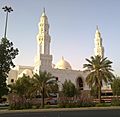Muhammad facts for kids
Quick facts for kids
Muhammad
مُحَمَّد |
|||||||||||||||||||||||||||||
|---|---|---|---|---|---|---|---|---|---|---|---|---|---|---|---|---|---|---|---|---|---|---|---|---|---|---|---|---|---|

"Muhammad the Apostle of God"
inscribed on the gates of the Prophet's Mosque in Medina |
|||||||||||||||||||||||||||||
| Born |
c. 570 |
||||||||||||||||||||||||||||
| Died | 8 June 632 (aged c. 62) Medina, Hejaz, Arabia
(present-day Saudi Arabia) |
||||||||||||||||||||||||||||
| Resting place |
Green Dome at al-Masjid an-Nabawi, Medina
(present-day Saudi Arabia) |
||||||||||||||||||||||||||||
| Other names |
|
||||||||||||||||||||||||||||
| Years active |
583–609 as merchant
609–632 as religious leader |
||||||||||||||||||||||||||||
|
Notable work
|
Constitution of Medina | ||||||||||||||||||||||||||||
| Successor | Succession to Muhammad | ||||||||||||||||||||||||||||
| Spouse(s) |
|
||||||||||||||||||||||||||||
| Children | Children | ||||||||||||||||||||||||||||
| Parent(s) | Abdullah ibn Abdul-Muttalib (father) Aminah bint Wahb (mother) |
||||||||||||||||||||||||||||
| Relatives | Family tree of Muhammad, Ahl al-Bayt ("Family of the House") | ||||||||||||||||||||||||||||
| Arabic name | |||||||||||||||||||||||||||||
| Personal (Ism) | Muhammad | ||||||||||||||||||||||||||||
| Patronymic (Nasab) | Muḥammad ibn 'Abd Allah ibn 'Abdul-Muttalib ibn Hashim ibn 'Abd Manaf ibn Qusai ibn Kilab | ||||||||||||||||||||||||||||
| Teknonymic (Kunya) | Abu al-Qasim | ||||||||||||||||||||||||||||
| Epithet (Laqab) | Khātim an-Nâbîyīn (Seal of the prophets) | ||||||||||||||||||||||||||||
| Signature | |||||||||||||||||||||||||||||
 |
|||||||||||||||||||||||||||||
Muhammad (Arabic: محمد; born around 570 AD – died June 8, 632 AD) was the person who started the religion of Islam. People who follow Islam, called Muslims, believe he was a special messenger and prophet from Allah (God).
Muslims believe Muhammad was a descendant of Ishmael, who was a son of Abraham. They also believe he was the last of all prophets, known as "the seal of the prophets." He is seen as an important example for all Muslims to follow in their lives.
Contents
Muhammad's Life Story
His Childhood
Muhammad was born around 570 AD in a city called Mecca. His father, Abdullah, passed away about six months before Muhammad was born. His mother, Amina, died when he was only seven years old.
After his mother's death, his grandfather, Abdul-Muttalib, took care of him. But his grandfather also died two years later, when Muhammad was nine. Then, his uncle Abu Talib became his guardian and supported him for many years.
How He Became a Prophet
In 610 AD, when Muhammad was forty years old, he often went to a mountain called Hira near Mecca. Muslims believe that one day, while he was in a cave on the mountain, the angel Jibrail spoke to him.
The story says that Muhammad was surprised by the angel Gabriel's large size. Jibrail told Muhammad:
"Read... in the name of God Who made man from a drop of blood... God is Most Rewarding... He Who taught man to write with pen... and taught man what he knew not."
Muhammad went home and told his wife, Khadijah, what had happened. More messages from God came to him, telling him to share what he was receiving. When Muhammad first started teaching, many people in Mecca worshipped idols. They did not like his message.
However, some people listened and followed his teachings. These were the first Muslims. The leaders of Mecca punished and hurt the early followers of Islam. Some were even killed. Muhammad kept teaching Islam despite these challenges.
The Journey to Medina
After a difficult time in Mecca, Muhammad decided to move his message to Medina. Some people in Medina had heard about him and his followers. They welcomed him to their city and agreed to become Muslims. Many of Muhammad's followers then moved to Medina.
This important journey from Mecca to Medina is called the Hijrah. The Hijrah also marks the beginning of the Islamic calendar. Muhammad stayed behind in Mecca until all his followers had safely left.
While Muhammad was still in Mecca, his uncle Abu Lahab planned with seven men to kill Muhammad in his sleep. But, according to history, they did not see him leave Mecca. The men entered his house and found his cousin, Ali, instead. Abu Lahab and his horsemen then searched for Muhammad and his friend, Abu Bakr, in the desert.
Life in Medina
Muhammad and Abu Bakr safely arrived in Medina. Many people welcomed Muhammad into their homes. He used his camel to show everyone where he would build his own house. The first mosque in Medina, a small place for prayer, was built behind this house.
Some people from a strong Jewish tribe in Medina disagreed with Muhammad's teachings and rules. This tribe told their allies in Mecca to sell the homes and belongings that Muslims from Mecca had left behind. The Muslims were advised to fight for their property. However, Muhammad told them not to fight.
Later, Muslims from all over Medina were called to gather at the mosque where Muhammad prayed. They were told to fight against the people of Mecca who had burned their homes and stolen their property.
Important Battles
The Battle of Badr
The Quraysh pagans of Mecca heard about this and sent a large army of 1000 warriors to fight the Muslims. They met at a place called Badr. The pagans were defeated, and Abu Jahl, one of their leaders, was killed.
The Battle of Uhud
However, the Muslims lost the second battle at Uhud. This happened one year after the fight at Badr. The army from Mecca had help from others. Muslim archers did not follow Muhammad's instructions, and Khalid ibn al-Walid cleverly used this to his advantage. Hamza, Muhammad's last uncle, was killed. Muhammad himself was injured in this battle.
The Battle of the Trench
Then, in 627 AD, Abu Sufyan led the Quraysh and their allies to attack Medina itself. But they could not get past a large trench that the Muslims had dug around Medina. After several weeks, the attacking groups gave up and went home. The people of Medina were seen as the winners.
Peace with Mecca
After the pagans of Mecca failed to take control of Medina, the Muslims became stronger. The pagans then decided to sign a truce with the Muslims. This meant they would not fight each other for ten years. The Muslims used this time to talk to other people all over Arabia. In just three years, many people changed their religion to Islam.
But this truce did not last long. After three years, a small group of horsemen from Mecca attacked a Muslim camp and killed some Muslims. When the Muslims in Medina heard about this, the truce was cancelled. Abu Sufyan, the third leader of Mecca during Muhammad's lifetime, tried to restart the truce, but Muhammad politely said no. Muhammad then told his followers to get ready to capture Mecca.
Capturing Mecca
In 630 AD, most people in Arabia had become Muslims. They joined Muhammad's large army to capture Mecca. Because the army was so big, the people of Mecca were afraid to fight back. Abu Sufyan, who was upset about the broken truce, went to Muhammad's camp outside Mecca to ask for forgiveness. Muhammad did not immediately say he would forgive him, so Abu Sufyan returned home. While he was with Muhammad, he became a Muslim by saying the Testimony (ash-Ashaada):
"I testify that there is no other god but Allah, and I testify that Muhammad is the Messenger of Allah."
The next day, the Muslim army marched towards Mecca. Everyone in Mecca ran to their homes and closed their doors and windows. They were afraid the Muslims would kill them because of the bad things they had done to Muslims many years ago. But the Muslims went towards the Ka'aba, which is believed to have been built by Abraham and his elder son, Ishmael.
Bilal ibn Ribah, who used to be a slave from Ethiopia, shouted loudly to the people of Mecca that they were all safe: "All those who lay down arms are safe. All those in the house of Abu Sufyan are safe. All those behind closed doors are safe."
Abu Sufyan heard this in his home. From this, he understood that Muhammad had forgiven him. At that time, Muhammad and his followers removed and broke all the idols from the Kaaba. These idols were statues that people used to worship as gods. Muhammad forgave all the people of Mecca. Finally, Bilal climbed to the top of the Kaaba and called for prayer. This was a great victory for Muhammad in spreading Islam across Arabia. However, because he was getting old, he would not live much longer.
His Death

In 632 AD, on June 8, Muhammad became very sick. Before he died, he spoke to his followers about his passing. He is buried in the room of his wife Aisha in Medina, where the Masjid al-Nabawi (Mosque of the Prophet) now stands. In Medina, his friend Abu Bakr went to the Masjid al-Nabawi and told the people:
"If any of you worship Muhammad, you should know that Muhammad is dead. But those of you who worship Allah(swt) (God), let it be known that Allah(swt) (God) is alive and cannot die."
Even though Muhammad died, Islam quickly spread across the Middle East. Then, over the centuries, it continued to reach Africa, Asia, and Europe. Islam has become one of the world's largest and fastest-growing religions.
Respect for Muhammad
When Muslims say or write Muhammad's name, they usually add Peace and Blessings be upon him (in Arabic: sall-Allahu `alayhi wa sallam). For example, "Muhammad (Peace and Blessings be upon him)." In printed books, a special symbol is often used instead of writing out the full phrase.
Sunni Muslims believe that Abu Bakr became the leader after Muhammad. Shias believe that Ali should have been the next leader.
Images for kids
Most Muslims do not create or display images of Muhammad. The Qur'an does not directly say that images of Muhammad must never be made. However, it does have parts that forbid making idols. There are also sayings in the Hadith against making images of God.
Muslims, especially Sunni Muslims, believe there should be no pictures of Muhammad. When people create images of Muhammad, some Muslims may find this disrespectful, offensive, and hurtful.
Muhammad's Wives
Muhammad married several women during his lifetime. These marriages often helped to strengthen ties between different groups and families. For example, he married Khadijah bint Khuwaylid, who was his first wife and a successful businesswoman. She was a great support to him. He also married widows, which was a way to help and protect them and their children in society.
Images for kids
-
Makkah Al Mukarramah Library (21°25′30″N 39°49′48″E / 21.42500°N 39.83000°E) is believed to stand on the spot where Muhammad was born, so it is also known as Bayt al-Mawlid
-
Muhammad receiving his first revelation from Gabriel in Jami' al-tawarikh by Rashīd al-Dīn Ṭabīb (1307)
-
The last verse from An-Najm: "So prostrate to Allah and worship." Muhammad's message of monotheism challenged the traditional order
-
The Masjid Al-Aqsa in Jerusalem, also known as the Haram ash-Sharif or the Temple Mount, takes its name from the "farthest mosque" described in Surah 17, where Muhammad travelled in his night journey.
-
Quranic inscriptions on the Dome of the Rock. It marks the spot Muhammad is believed by Muslims to have ascended to heaven.
-
The Masjid al-Qiblatayn, where Muhammad established the new Qibla, or direction of prayer
-
A hilya containing a description of Muhammad, by Ottoman calligrapher Hâfiz Osman (1642–1698)
-
The tomb of Muhammad is located in the quarters of his third wife, Aisha. (Al-Masjid an-Nabawi, Medina)
-
The Muslim profession of faith, the Shahadah, illustrates the Muslim conception of the role of Muhammad: "There is no god except the God; Muhammad is the Messenger of God." in Topkapı Palace, Istanbul, Turkey
-
Muhammad in La vie de Mahomet by M. Prideaux (1699). He holds a sword and a crescent while trampling on a globe, a cross, and the Ten Commandments.
See also
 In Spanish: Mahoma para niños
In Spanish: Mahoma para niños















